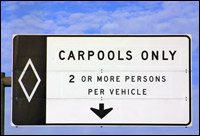transportation
-
Let's not pretend the government isn't encouraging suburbs
There are a great many ways in which the government shapes our land-use patterns. Sprawl apologists often argue that low-density, suburban-style development has dominated the American landscape over the past half century because it is clearly superior to alternatives. Now, there's no doubt that many Americans prefer suburban life.
At the same time, it's impossible to ignore the overwhelming way in which government policy has encouraged such development, intentionally, and unintentionally. The government didn't necessarily intend for a massive network of (largely) free-to-user highways to spur suburban growth and gut urban centers, but that's what happened. Similarly, the government's long-term commitment to increased rates of home-ownership wasn't necessarily about changing land-use patterns. But as economist Ed Glaeser notes at the New Republic, the relationship between the policy and the outcome is clear:
Roughly 87 percent of all single-family detached homes are owner-occupied. Roughly 87 percent of all homes in buildings with five or more units are rented. Multi-family dwellings have common spaces, such as lobbies, and common infrastructure; sharing joint control over these things can often be quite difficult. Landlord control over large buildings irons out the difficulties of dealing with the cacophony of collective control.
The connection between homeownership and structure type implies that when the federal government gets into the business of supporting homeownership, it also gets into the business of supporting single-family detached homes -- and this means supporting lower-density living. New Yorkers have converted plenty of rental units into co-ops, but still 77 percent of the households in Manhattan rent. The government's big post-war push into homeownership was inevitably also a push to suburbanize. You do not need to be an enemy of the suburbs to wonder why the government is implicitly urging Americans to drive longer distances and flee denser living.Of course, this is just one of many reasons why we should be skeptical of policies that subsidize homeownership. Such subsidies are regressive. They encourage heavy, leveraged investments in undiversified assets that perform unexceptionally over time. They reduce mobility, which prevents households from responding to changing economic conditions. And should there be a massive housing bubble and collapse, they put millions of households at risk of foreclosure and bankruptcy and contribute to global economic meltdown.
But for all this, the odds of a reversal of these policies, like the mortgage interest reduction, are basically zero. Which is yet another reason that we ought to focus on undoing other suburban subsidies wherever it's politically feasible. Congestion pricing, which could address crowded freeways while funding better urban transport, is a good place to start.
-
Push continues for more green infrastructure funding in the economic-stimulus package
Senate Democrats on Sunday convinced President-elect Barack Obama to add more money for clean-energy tax credits to his economic-stimulus plan, doubling available funds to at least $20 billion.
Horse-trading is sure to continue as the Obama team and congressional leaders try to agree on what should be included in a package that could cost more than $775 billion. The initial Obama plan didn't include details on how much would go toward infrastructure and didn't specifically mention mass-transit funding, though it called for doubling the production of renewable energy and retrofitting the majority of federal buildings. Some enviros and transit advocates are concerned that the stimulus plan could put massive amounts of money into traditional infrastructure without taking into account the long-term environmental impacts.
And in his Saturday radio/YouTube address, Obama said the plan would create nearly half a million jobs through clean energy investments, including doubling the amount of renenwable energy used in the country and retrofitting the majority of federal buildings. "These made-in-America jobs building solar panels and wind turbines, developing fuel-efficient cars and new energy technologies pay well, and they can’t be outsourced," said Obama (who still hasn't explained exactly why wind turbines and solar panels can't be constructed elsewhere).
-
How to put the brakes on employee driving
Even before last month’s Gulf Coast catastrophes sent the nation’s oil companies scurrying to hike gas prices, the cost of driving to work was nearing the pain point. And not just the price of filling up: as average commute times have grown over the past five years, even in green-minded cities like Portland, Ore., and […]
